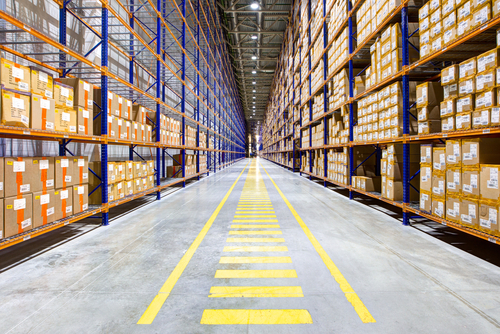Few businesses can compete with Amazon—not just as a retailer, but also in shipping, data management, and even warehousing. To become the juggernaut it is today, Amazon has evolved to provide many of its necessary service needs.

For its warehousing needs alone, for example, Amazon reportedly owns nearly 319 million square feet of fulfillment center floor space in the United States. Though that is a massive number, consider that Amazon’s warehouse placement is designed to keep shipping times as low as possible. In other words, Amazon warehouses have been strategically placed all over the country.
Strategic warehousing allows Amazon to ensure that goods are already nearby when a customer places an order. It also enables the company to focus on efficiency and cost-effectiveness for shipping. This is how Amazon can offer free next-day or two-day shipping.
With these facts in mind, let’s look at how strategic warehouse placement can help other companies reduce their shipping times.
Less Time on the Road
Transportation occupations are some of the most dangerous jobs. In 2018 alone, workers’ injuries and illnesses in transportation and material moving accounted for 20% of all injuries. These statistics also include related transportation roles, such as mechanics and transport-related warehouse jobs.
Strategic warehouse placement reduces the time that trucks and other transport options need to be used. Shorter travel periods can also decrease the time that vehicles are on the road and, thus, can help with driver fatigue. Furthermore, using strategic warehouse placement in high-volume areas will:
- Ensure the fastest shipping times by decreasing the hindrance of supply bottlenecks.
- Keep high-volume items well-stocked, eliminating unplanned shipments.
- Benefit from courier usage to deliver goods where larger delivery options may struggle (such as residential or historic areas).
Additionally, warehouses built in strategic locations can reduce the load of other warehouses. Not only does this decrease shipping times in the area, but it also increases the efficiency of the once-beleaguered warehouse.
Optimization In, Optimization Out
A strategically placed warehouse is optimized inside and out. Shipping costs and speeds are affected by more than the distance. Without optimized functions and employees, warehouses and shipping will suffer.
No matter the industry, however, warehouse safety is essential. Injured workers won’t be working, and could be costing money. Perhaps more importantly, a poorly managed warehouse will drag down morale, handling speeds, and efficiency. Mistakes will pile up, just like the hazards that surround the workers.
To achieve an optimized and safe warehouse, the following guidelines must be followed:
- Rigid daily protocols, especially around safety, awareness, and internal assistance.
- Incentivize safe efficiency, not bottom-line numbers. Breakneck speed is only temporarily sustainable.
- Storage and organization pipelines must always be adhered to.
- Use optimized scheduling to keep shipping and receiving on different shifts.
Each of the above-mentioned tips not only ensures smooth operations, but also keeps the employees and their safety in mind. Unless the warehouse is entirely automated, optimization must consider the humans within.
Technology and automation should still be used, but focus on systems that work with the human element in mind. Use machine learning and logic-oriented technologies to study your warehouse statistics. Optimize how the team at hand works, instead of forcing them into a “pre-optimized mold.”
In short, if the warehouse and its employees are optimized, then shipping times too will be optimized.
Strategic Location Keeps the Goods Close By
Today’s supply chain management goals are meant to ensure customer satisfaction. Two-day or next-day shipping is no longer a leg up over other services. Rapid shipping is now the expected offering. Larger fleets or faster processing lines alone won’t speed up shipping times if the warehouse is located across the country.
Therefore, strategically placing warehouses ensures that goods are always within your customers’ desired shipping times. Amazon’s vast number of warehouses allow for same-day shipping in some areas. Often, within hours of an online order, the purchased item is at the customer’s door. It doesn’t get much faster than that. This is achieved by the vast amount of strategic square footage Amazon devotes to customer satisfaction.
Of course, not every business can afford millions of feet of storage space. Still, a company can decide where best to locate the storage it can afford. For example, warehouses next to major shipping hubs can take better advantage of increased shipping options. Major metropolitan areas benefit from having warehouses nearby, especially in high-volume areas.
Large metropolitan areas also provide other strategic benefits, including:
- Better access to existing infrastructure.
- A more significant potential labor pool.
- A greater area of serviceable customers, plus the ability to offer reduced shipping times to a major section of customers.
Keeping warehouses close to the manufacturing locations can reduce shipping times on the back end. However, strategically located warehouses next to major shipping hubs can benefit from nearly the same back-end fulfillment, and provide customers with even quicker delivery times.
Final Thoughts
Warehouses use massive amounts of capital, both in start-up mode and during normal operations. They can be dangerous, especially with a high-velocity mix of employees and machinery. Warehouse use and placement must therefore be strategic to maximize efficiency at all levels. From employee safety to customer satisfaction, where you place a warehouse has long-existing ramifications.
Companies have found success working backward with the customer as the end goal. Strategically located warehouses allow logistics to focus on the fastest route to the customer. Be it extra stock for a high-volume item, or simply shorter shipping times from the warehouse to the customer’s door, warehouse placement is critical.
Rachel Perez is an Outreach Associate with North Star Inbound and wrote this piece working in tandem with BigRentz. An honors graduate of New York University, she is passionate about writing about business, e-commerce, construction, and travel. When not writing, she enjoys spending time in the Florida sunshine.
